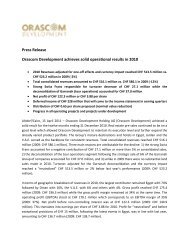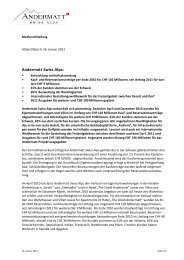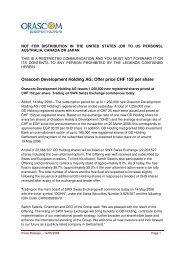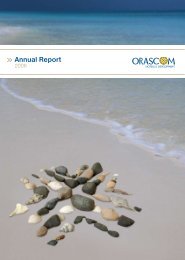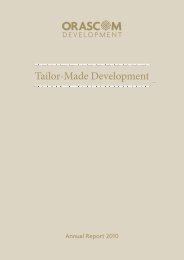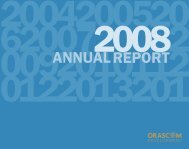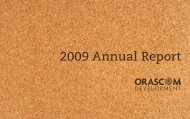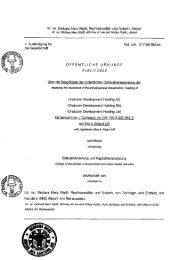FY 2010 Annual Report - Part II - Orascom Development
FY 2010 Annual Report - Part II - Orascom Development
FY 2010 Annual Report - Part II - Orascom Development
You also want an ePaper? Increase the reach of your titles
YUMPU automatically turns print PDFs into web optimized ePapers that Google loves.
ODH <strong>Annual</strong> <strong>Report</strong> <strong>2010</strong><br />
Where the non-controlling interests have arisen from business<br />
combinations for which the acquisition date is prior to 1 January<br />
<strong>2010</strong>, the non-controlling shareholders are initially measured at<br />
the non-controlling interests’ proportionate share of the fair value<br />
of the acquiree’s identifiable net assets, at the date of the original<br />
business combination. Subsequent to acquisition, the carrying<br />
amount of non-controlling interests is the amount of those<br />
interests at initial recognition plus the non-controlling interests’<br />
share of subsequent changes in equity. Total comprehensive<br />
income is attributed to non-controlling interests to the extent of<br />
the carrying amount of those non-controlling interests. Losses<br />
applicable to the non-controlling shareholders in excess of their<br />
interests in a subsidiary’s equity are allocated against the interests<br />
of the Group except to the extent that the non-controlling<br />
shareholders have a binding obligation and are able to make an<br />
additional investment to cover the losses.<br />
As to other business combinations for which the acquisition date<br />
is on or after 1 January <strong>2010</strong>, the Group applies the<br />
requirements of IFRS 3 (as revised in 2008) for initial and<br />
subsequent measurement of the non-controlling interests (see 3.8<br />
below).<br />
Changes in the Group's ownership interests in existing subsidiaries<br />
Changes in the Group's ownership interests in subsidiaries that do<br />
not result in the Group losing control over the subsidiaries are<br />
accounted for as equity transactions. The carrying amounts of the<br />
Group's interests and the non-controlling interests are adjusted to<br />
reflect the changes in their relative interests in the subsidiaries.<br />
Any difference between the amount by which the non-controlling<br />
interests are adjusted and the fair value of the consideration paid<br />
or received is recognised directly in equity and attributed to<br />
owners of the Parent Company.<br />
When the Group loses control of a subsidiary, the profit or loss<br />
on disposal is calculated as the difference between (i) the<br />
aggregate of the fair value of the consideration received and the<br />
fair value of any retained interest and (ii) the previous carrying<br />
amount of the assets (including goodwill), and liabilities of the<br />
subsidiary and any non-controlling interests. When assets of the<br />
subsidiary are carried at re-valued amounts or fair values and the<br />
related cumulative gain or loss has been recognised in other<br />
comprehensive income and accumulated in equity, the amounts<br />
previously recognised in other comprehensive income and<br />
accumulated in equity are accounted for as if the Parent<br />
Company had directly disposed of the relevant assets (i.e.<br />
reclassified to profit or loss or transferred directly to retained<br />
earnings as specified by applicable IFRSs). The fair value of any<br />
investment retained in the former subsidiary at the date when<br />
control is lost is regarded as the fair value on initial recognition<br />
for subsequent accounting under IAS 39 Financial Instruments:<br />
Recognition and Measurement or, when applicable, the cost on<br />
initial recognition of an investment in an associate or a jointly<br />
controlled entity.<br />
3.8 Business combinations<br />
In compliance with the requirements of IFRS 3 (as amended in<br />
2008), the Group adopted a new accounting policy for business<br />
combinations for which the acquisition date is on or after 1<br />
January <strong>2010</strong> as set out below. The acquisition date is the date<br />
on which the acquirer obtains control of the acquiree.<br />
Acquisitions of businesses are accounted for using the acquisition<br />
method. The consideration transferred in a business combination<br />
is measured at fair value, which is calculated as the sum of the<br />
acquisition-date fair values of the assets transferred by the Group,<br />
liabilities incurred by the Group to the former owners of the<br />
acquiree and the equity interests issued by the Group in exchange<br />
for control of the acquiree. Acquisition-related costs are generally<br />
recognised in profit or loss as incurred.<br />
At the acquisition date, the identifiable assets acquired and the<br />
liabilities assumed are recognised at their fair value at the<br />
acquisition date, except that:<br />
– deferred tax assets or liabilities and liabilities or assets<br />
related to employee benefit arrangements are recognised<br />
and measured in accordance with IAS 12 Income Taxes and<br />
IAS 19 Employee Benefits respectively;<br />
– liabilities or equity instruments related to share-based<br />
payment arrangements of the acquiree or share-based<br />
payment arrangements of the Group entered into to replace<br />
share-based payment arrangements of the acquiree are<br />
measured in accordance with IFRS 2 Share-based Payment<br />
at the acquisition date; and<br />
– assets (or disposal groups) that are classified as held for sale<br />
in accordance with IFRS 5 Non-current Assets Held for Sale<br />
and Discontinued Operations are measured in accordance<br />
with that Standard.<br />
Goodwill is measured as the excess of the sum of the<br />
consideration transferred, the amount of any non-controlling<br />
interests in the acquiree, and the fair value of the acquirer's<br />
previously held equity interest in the acquiree (if any) over the net<br />
of the acquisition-date amounts of the identifiable assets acquired<br />
and the liabilities assumed. If, after reassessment, the net of the<br />
acquisition-date amounts of the identifiable assets acquired and<br />
liabilities assumed exceeds the sum of the consideration<br />
transferred, the amount of any non-controlling interests in the<br />
acquiree and the fair value of the acquirer's previously held<br />
interest in the acquiree (if any), the excess is recognised<br />
immediately in profit or loss as a bargain purchase gain.<br />
Non-controlling interests that are present ownership interests and<br />
entitle their holders to a proportionate share of the entity's net<br />
assets in the event of liquidation may be initially measured either<br />
at fair value or at the non-controlling interests' proportionate<br />
share of the recognised amounts of the acquiree's identifiable net<br />
assets. The choice of measurement basis is made on a<br />
transaction-by-transaction basis. Other types of non-controlling<br />
interests are measured at fair value or, when applicable, on the<br />
basis specified in another IFRS.<br />
When the consideration transferred by the Group in a business<br />
combination includes assets or liabilities resulting from a<br />
contingent consideration arrangement, the contingent<br />
consideration is measured at its acquisition-date fair value and<br />
included as part of the consideration transferred in a business<br />
combination. Changes in the fair value of the contingent<br />
consideration that qualify as measurement period adjustments are<br />
adjusted retrospectively, with corresponding adjustments against<br />
goodwill. Measurement period adjustments are adjustments that<br />
arise from additional information obtained during the<br />
‘measurement period’ (which cannot exceed one year from the<br />
acquisition date) about facts and circumstances that existed at the<br />
acquisition date.<br />
The subsequent accounting for changes in the fair value of the<br />
contingent consideration that do not qualify as measurement<br />
period adjustments depends on how the contingent consideration<br />
is classified. Contingent consideration that is classified as equity is<br />
not re-measured at subsequent reporting dates and its subsequent<br />
settlement is accounted for within equity. Contingent<br />
consideration that is classified as an asset or a liability is remeasured<br />
at subsequent reporting dates in accordance with IAS<br />
39, or IAS 37 Provisions, Contingent Liabilities and Contingent<br />
Assets, as appropriate, with the corresponding gain or loss being<br />
recognised in profit or loss.<br />
When a business combination is achieved in stages, the Group's<br />
previously held equity interest in the acquiree is re-measured to<br />
fair value at the acquisition date (i.e. the date when the Group<br />
F-14



